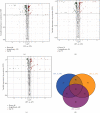Widely Targeted Metabolomics Analysis Reveals Key Quality-Related Metabolites in Kernels of Sweet Corn
- PMID: 33628768
- PMCID: PMC7884158
- DOI: 10.1155/2021/2654546
Widely Targeted Metabolomics Analysis Reveals Key Quality-Related Metabolites in Kernels of Sweet Corn
Abstract
Sweet corn (Zea mays convar. saccharata var. rugosa) is a major economic vegetable crop. Different sweet corn cultivars vary largely in flavor, texture, and nutrition. The present study performed widely targeted metabolomics analysis based on the HPLC-MS/MS technology to analyze the metabolic profiles in three sweet corn cultivars widely grown in China. A total of 568 metabolites in the three sweet corn cultivars were detected, of which 262 differential metabolites significantly changed among cultivars. Carbohydrates, organic acids, and amino acids were the majority detected primary metabolites. Organic acids were mainly concentrated on shikimate, benzoic acids, and quinic acid with aromatic groups. And the essential amino acids for the human body, methionine and threonine, were highly accumulated in the high-quality cultivar. In addition, phenylpropanoids and alkaloids were the most enriched secondary metabolites while terpenes were low-detected in sweet corn kernels. We found that the flavonoids exist in both free form and glycosylated form in sweet corn kernels. PCA and HCA revealed clear separations among the three sweet corn cultivars, suggesting distinctive metabolome profiles among three cultivars. The differential metabolites were mapped into flavonoid biosynthesis, phenylpropanoid biosynthesis, biosynthesis of amino acids, and other pathways according to the KEGG classification. Furthermore, we identified skimmin, N',N″-diferuloylspermidine, and 3-hydroxyanthranilic acid as the key quality-related metabolites related to grain quality traits in sweet corn. The results suggested variations of metabolic composition among the three cultivars, providing the reference quality-related metabolites for sweet corn breeding.
Copyright © 2021 Ruichun Yang et al.
Conflict of interest statement
The authors declare no conflict of interest.
Figures





Similar articles
-
Impact of low temperature on the chemical profile of sweet corn kernels during post-harvest storage.Food Chem. 2024 Jan 15;431:137079. doi: 10.1016/j.foodchem.2023.137079. Epub 2023 Aug 3. Food Chem. 2024. PMID: 37573745
-
Characterization of volatile metabolites in temperate and tropical sweet corn cultivars under various post-harvest storage conditions.Food Chem X. 2024 Nov 26;24:102020. doi: 10.1016/j.fochx.2024.102020. eCollection 2024 Dec 30. Food Chem X. 2024. PMID: 39670255 Free PMC article.
-
Zeaxanthin biofortification of sweet-corn and factors affecting zeaxanthin accumulation and colour change.Arch Biochem Biophys. 2015 Apr 15;572:184-187. doi: 10.1016/j.abb.2015.01.015. Epub 2015 Jan 28. Arch Biochem Biophys. 2015. PMID: 25637659
-
A comparative metabolomics study of flavonoids in sweet potato with different flesh colors (Ipomoea batatas (L.) Lam).Food Chem. 2018 Sep 15;260:124-134. doi: 10.1016/j.foodchem.2018.03.125. Epub 2018 Mar 27. Food Chem. 2018. PMID: 29699652
-
The Application of Metabolomics for the Study of Cereal Corn (Zea mays L.).Metabolites. 2020 Jul 23;10(8):300. doi: 10.3390/metabo10080300. Metabolites. 2020. PMID: 32717792 Free PMC article. Review.
Cited by
-
Comparative nutritional and metabolic analysis reveals the taste variations during yellow rambutan fruit maturation.Food Chem X. 2023 Jan 19;17:100580. doi: 10.1016/j.fochx.2023.100580. eCollection 2023 Mar 30. Food Chem X. 2023. PMID: 36845499 Free PMC article.
-
Adaptive Changes in Detoxification Metabolism and Transmembrane Transport of Bombyx mori Malpighian Tubules to Artificial Diet.Int J Mol Sci. 2023 Jun 9;24(12):9949. doi: 10.3390/ijms24129949. Int J Mol Sci. 2023. PMID: 37373097 Free PMC article.
-
Metabolic Profiling and Potential Taste Biomarkers of Two Rambutans during Maturation.Molecules. 2023 Feb 1;28(3):1390. doi: 10.3390/molecules28031390. Molecules. 2023. PMID: 36771060 Free PMC article.
-
Integrated comparative metabolomics and network pharmacology approach to uncover the key active ingredients of Polygonati rhizoma and their therapeutic potential for the treatment of Alzheimer's disease.Front Pharmacol. 2022 Aug 4;13:934947. doi: 10.3389/fphar.2022.934947. eCollection 2022. Front Pharmacol. 2022. PMID: 35991900 Free PMC article.
-
Integrated omic profiling of the medicinal mushroom Inonotus obliquus under submerged conditions.BMC Genomics. 2023 Sep 19;24(1):554. doi: 10.1186/s12864-023-09656-z. BMC Genomics. 2023. PMID: 37726686 Free PMC article.
References
-
- Singh I., Langyan S., Yadava P. Sweet corn and corn-based sweeteners. Sugar Tech. 2014;16(2):144–149. doi: 10.1007/s12355-014-0305-6. - DOI
-
- Butrón A., Álvarez A., Revilla P., et al. Agronomic performance of sweetcorn populations derived from crosses between sweetcorn and field corn. Spanish Journal of Agricultural Research. 2008;6(3):378–384. doi: 10.5424/sjar/2008063-330. - DOI
LinkOut - more resources
Full Text Sources
Other Literature Sources

